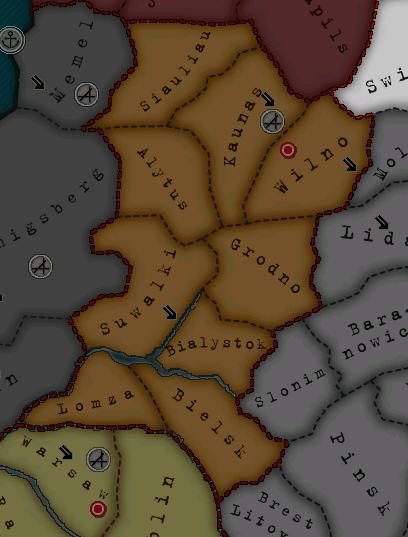Lithuania
From Kaiserreich
| Line 1: | Line 1: | ||
[[Image:litplac.jpg|thumb|150px|Lithuania and it's neighbors]] | [[Image:litplac.jpg|thumb|150px|Lithuania and it's neighbors]] | ||
| - | '''Lithuania''' (Lithuanian: ''Lietuva'') is one of the two Baltic countries in Europe. However, it does not have sea access. It is bordered by Germany, the | + | '''Lithuania''' (Lithuanian: ''Lietuva'') is one of the two Baltic countries in Europe. However, it does not have sea access. It is bordered by Germany, the United Baltic Duchy and White Ruthenia. |
== Politics == | == Politics == | ||
Revision as of 16:38, 31 October 2007
Lithuania (Lithuanian: Lietuva) is one of the two Baltic countries in Europe. However, it does not have sea access. It is bordered by Germany, the United Baltic Duchy and White Ruthenia.
Politics
Military affiliations
It is part of the Mitteleuropa military and economic alliance. It's army is heavily reliant on the German system.
History
Following the Third Partition of Poland in 1795, Lithuania was split between the Russian Empire and Prussia, Russia getting most of the territory. After Napoleon's campaign in Russia ended in disaster, Tsar Nicholas I began an intensive program of Russification. The Lithuanians and Poles revolted twice, in 1831 and 1863, but both attempts failed. In 1864 the Lithuanian language and the Latin alphabet were banned in junior schools. Lithuanians resisted the Russification by arranging printing abroad and smuggling the books in. The national revival started among poor people in the late years of Russian occupation, then continued with the wealthy, beginning with the release of Lithuanian newspapers, Ausra and Varpas, then with the writing of poems and books in Lithuanian. These writings glorified the Grand Duchy of Lithuania, depicting the nation with power and many heroes.
This revival spearheaded the independence movement, with various organizations opposing Russian influence. Russian policy became harsher in response and there are known to have been strikes against Catholic churches, while a ban of the Lithuanian press still continued. Despite Russian attempts to integrate Lithuania by the end of the 19th century Lithuania had developed a growing nationalist movement. During the Russia-wide revolutionary upsurge of 1905 a congress of Lithuanian representatives in Vilnius on 5 December 1905 demanded provincial autonomy.
During World War I Lithuania's occupation by Germany and the subsequent collapse of the Russian imperial government led to the proclamation of an independent republic on February 16, 1918 under German control, and full independence in November 1918. On the 11th of July 1918, King Mindaugas II (born as HSH Prince Wilhelm Karl Florestan Gero Crescentius of Urach, Count of Württemberg) was crowned as King of Lithuania. Lithuania Minor was kept under German control, and the border settled between the German Baltic state and Lithuania meant that that the latter would be deprived of any sea access. Mindaugas II was succeeded following his death on the 24th of March 1928 by his son, crowned Mindaugas III.

